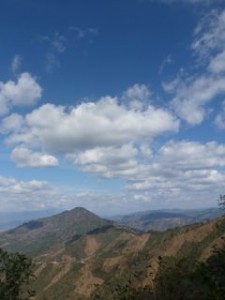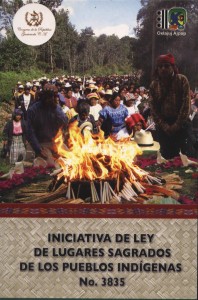
Earlier in 2012 the Sacred Natural Sites Initiative visited the Guatemalan Mayan Conference of Spiritual Leaders, Oxlajuj Ajpop. During a long ride at the back of a lorry, Oxlajuj Ajpop’s director Felipe Gomez explains how Mayan people are currently struggling to restore a network of ancestral sacred natural sites that are increasingly threatened by resource development and religious groups.

Chu Sagrib-al, in in north western Guatemala, is a sacred mountain to the Maya described in the Popul Vuh as the place of the awakening of the sun. Photo: Bas Verschuuren.
We are on our way to Chu Sagrib’al, an ancient sacred mountain described in the Popul Vuh – the ancient holy book of the Mayas – as “the place where the sun awoke”, literally indicating the dawn of an era. As Felipe talks, the sacred mountain slowly grows in size as we move towards it. The lorry is filled with ceremonial regalia and Maya in ceremonial dress that have flocked from around the area, anxious to get back to the mountain to maintain the sacred bonding with their special places.
Whilst climbing up the mountain, Felipe explains that after the civil wars many community lands were subdivided and ownership was passed on to individuals in the community. Oxlajuj Ajpop acquired the mountain from local landowners several years ago in order to protect it from overgrazing and mineral exploitation. The top of the mountain is now fenced and around the ceremonial site, local people are making plans to collect native seeds and restore the natural vegetation so that the forests and streams can be protected once again.
Oxlajuj Ajpop worked tirelessly for over 14 years to develop a law on the management of sacred sites. This law was finally welcomed by Guatemalan parliament in 2008. In accordance with international laws such as ILO 169 and UNDRIP, the law passes the responsibility for sacred sites into the hands of indigenous Maya, Garifuna and Xinca people and seeks to secure access the right of access, to perform ceremony and to the cultural management of sacred natural and constructed sites.
Despite the fact that the law gains increasing support from various ministries, it has still not officially been adopted. This appears mostly due to ambiguous opposition from those who protect private interests in fear of companies losing access to the natural resources found in areas where sacred sites occur. Although many of these interests help spur a free market in economy, it often so happens that they also add to even more examples of the violation of indigenous peoples rights to their territories and ways of life. Fortunately, the Mayan sacred natural sites are also found increasingly important to others in parliament says Felipe Gomez:
The ministry of culture supports the protection of sacred natural sites, but it endorses the status of “national monument” only to the altar on top of the mountain while to us Maya, the entire mountain – including its forests, waters and biodiversity – is sacred.
In an attempt to explain the potential impacts of the law to various ministries, Oxlajuj Ajpop has developed a booklet that delineates implementation pathways and explains the potential legal reforms required in the areas of forestry, water management and nature conservation. In order to make a case for reinstitution of indigenous rights, Oxlajuj Ajpop is building on the constitution that envisions Guatemala as a pluri legal and multi cultural state.
On top of Chu Sagri’al, the ceremony had come to a close. As customary to Mayan tradition, people conferred about the future of their sacred sites in contemporary society. Subsequently, there was time for recognition for the role of Oxlajuj Ajpop. It became increasingly clear that Oxlajuj Ajpop is playing a vital role in voicing local concerns at the national level.
Bringing local people and their voices into dialogue with policy makers and sectors of industry in a successful and constructive manner is a respectful task. As The Sacred Natural Sites Initiative is working to assist Oxlajuj Ajpop with the further protection of sacred sites beyond 2012, we are looking towards the future with a view of sharing more of these rich experiences with other custodians around the world.
Learn more about sacred sites in guatemala, view the video in the Media Gallery. Read more about the formation of the law in the case study archive or in IUCN’s ‘Policy Matters’







